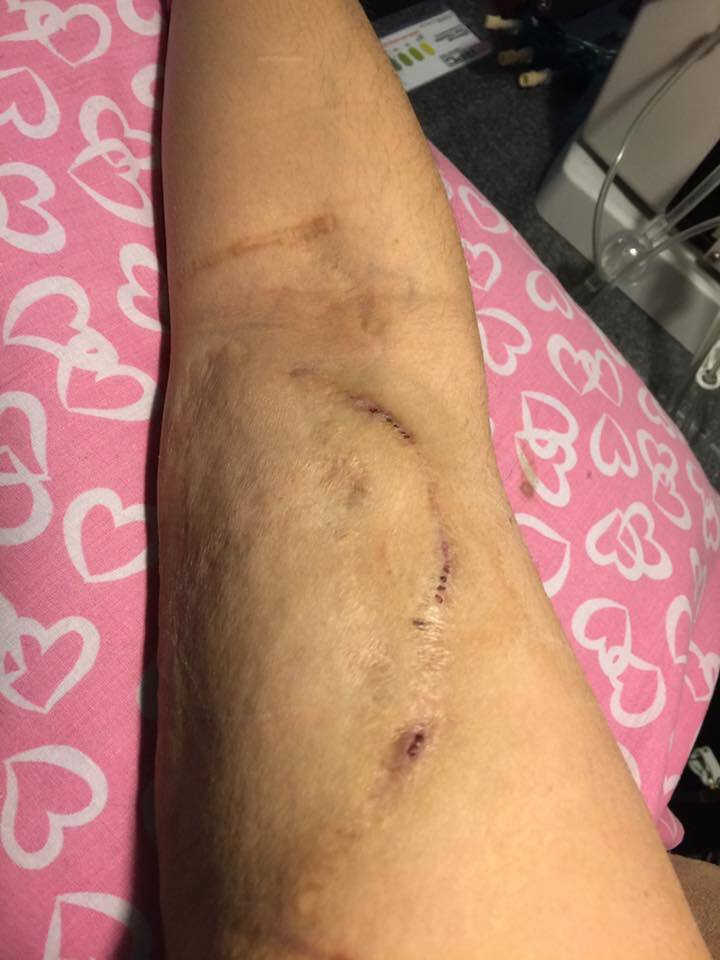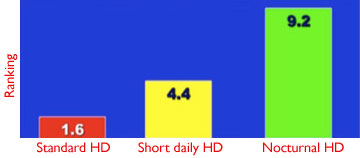Hitting Below the Belt: Home Dialysis and Sexuality
 Kidney failure can wreak havoc with your sex life. But it doesn't have to! Your treatment choice can impact your mood, body image, energy level, and libido. Knowing how your choice may affect you can help you choose an option that will give you the best life possible.
Kidney failure can wreak havoc with your sex life. But it doesn't have to! Your treatment choice can impact your mood, body image, energy level, and libido. Knowing how your choice may affect you can help you choose an option that will give you the best life possible.
Dialysis and mood
It's hard to be intimate with a partner when you feel depressed or anxious. Both are all too common. Between 20 and 33% of dialyzors have depression. Anxiety is present in a quarter 1 to nearly half. 2
Why so many? In the past, it was thought that kidney failure was just…depressing. But there seems to be more to the story. New studies have found links between depression, anxiety, and too many toxins in the blood.
- Clue 1: Dialyzors who have more kidney function are far less likely to be depressed. 3 More toxins are removed with more kidney function.
- Clue 2: People who use polysulfone dialyzors had far less depression than those using cellulose. 4 Polysulfone removes more toxins.
- Clue 3: Depressed and anxious people on dialysis had far higher levels of the toxin interleukin-6. 5 A possible culprit?
What may boost your mood and help your love life? More dialysis. People who switched from standard HD to short daily (SDHD)—5–6 short treatments per week—had much higher mental health scores. 6 And those who did peritoneal dialysis (PD) or nocturnal HD were less depressed than those who did standard in-center HD. 7
Coping with a changed body image
 No one survives kidney failure without scars. HD or PD catheters, grafts, fistulas, dialysis, and transplant all leave marks on your body.
No one survives kidney failure without scars. HD or PD catheters, grafts, fistulas, dialysis, and transplant all leave marks on your body.
Only a handful of studies have even looked at body image in people on dialysis. Interviews with other people on dialysis find that you are not alone if you feel like your HD access has maimed you, 8,9 or if you are upset about weight gain due to PD or transplant meds. 8
How can you feel sexy with a changed body? A study of people who lived for 15 years or more on HD found that they gave themselves a key message: "I'm still me." 10 You are more than your body. And YOU are still YOU, scars and all. How many people leave this life without scars, kidney failure or not?
PD and body image
PD has two main body image concerns: weight gain and the PD catheter. PD weight gain in one study ranged from just 5 lbs. to nearly 35. 11 But gains did not match up with extra calories from PD fluid. Instead, having a certain gene that controls how your body handles energy seems to make some people more prone to high weight gain (22+ lbs.) on PD. 12,13 So, you may or may not gain much. Reducing other diet starches (sugar, corn, potatoes, grains) may help prevent gains.
A rounded tummy can occur with PD, too, if stomach muscles are weak when you start. Women can dress around a PD belly by choosing clothes like jackets with straight up and down lines, or tunic type tops instead of body-hugging fashions.
Having a PD catheter coming out of your body takes some getting used to. Presternal PD catheters are placed in the chest and go into the belly. These may be less of a problem for body image than the more-common abdominal ones. 14 A presternal catheter can also allow tub baths. You can cover a PD catheter with gauze when you want to be intimate. Or, while you may feel self-conscious about a PD catheter, it may not bother your partner! Talk about how you feel. Knowing that he or she is okay with the catheter may help you accept it yourself.
HD and body image
You need an access (fistula, graft, catheter) for any type of HD. Having a healthy arm or leg marred can be hard to cope with. Some avoid fistulas and grafts, only to learn the hard way that HD catheters cause scars on the chest, which show. And they're 2.5 times more likely to kill you! 15 Coming to terms with an HD access can help your sex life and your life.
"Reframing" (thinking differently) has helped some people deal with HD access:
"I've had over 5 grafts and a fistula inserted over the years, along with probably two dozen catheters in my chest. It's all part of staying alive and in all honesty if a person really loves you the scars don't matter."
"Those 'bumps' on your arm are your Badge of Honor for fighting the good fight and staying alive!"
"I'm 28, a girl, and very self conscious about being on dialysis. Recently I decided to start wearing short-sleeve shirts and to not think about my arm. No one asks me about it. If I find them staring, it is for only a second as they walk by. I surround myself with loving and caring people who don't judge me, and if strangers want to stare then let them stare."
Other HD body image concerns can vary, based on type of HD. Yellow skin tone? Fragile skin that tears easily or has purple sores? Ammonia breath? These mean toxins are building up due to not enough HD. People who switch to daily or nocturnal HD "pink up" with more treatment. Their skin and bad breath clear up.
Sleep, fatigue, and energy
 How well you sleep and your energy level can have a big impact on your sex life. When you feel wiped out all the time, sex is quite likely the
last
thing on your mind. Lack of sleep can make depression worse, too.
16
So, how does your treatment choice affect you?
How well you sleep and your energy level can have a big impact on your sex life. When you feel wiped out all the time, sex is quite likely the
last
thing on your mind. Lack of sleep can make depression worse, too.
16
So, how does your treatment choice affect you?
- Standard in-center HD
- 60 to 97% of people who use standard HD say they have fatigue—and 94% would do more-frequent HD if it would help give them more energy. 17 After one year on standard HD, it took an average of 7.36 hours to feel well again after a treatment. 18 This option was also linked with the worst sleep (vs. PD or nocturnal HD). 19
- Peritoneal dialysis
- People who do PD don't feel the ups and downs of standard HD. Their energy levels are constant. But more than 50% of those on PD report sleep problems. These include restless legs, sleep apnea (breathing stops many times at night during sleep), and feeling sleepy during the day. 20
- Short daily HD (SDHD)
- It took just 16 minutes, on average, for people to feel well again after an SDHD treatment. 17 There are no studies yet on whether SDHD aids sleep.
- Nocturnal HD (NHD)
- It took just 4.3 minutes, on average, for people to feel well again after an NHD treatment. 17 NHD brought levels of melatonin (a sleep hormone) back to normal, too. 18 One study found far better sleep even on in-center nocturnal—where you might think that sleeping with others in the clinic with you would be a problem. 21
 With
any
dialysis option, exercise can help boost your mood and energy level, and help your heart and blood vessels work better.
22
If you've been sitting on the couch and it's been a while since you were active, talk to your doctor. Medicare will pay for a physical therapy visit to get you started.
With
any
dialysis option, exercise can help boost your mood and energy level, and help your heart and blood vessels work better.
22
If you've been sitting on the couch and it's been a while since you were active, talk to your doctor. Medicare will pay for a physical therapy visit to get you started.
Libido and sexual function
Do you even want to have sex? A very common finding among people on standard in-center HD is a lack of desire, or libido. This occurs in both men and women: 23
"I have NO sex drive. This is a HORRIBLE feeling, especially since I'm in a relationship. My mate is very understanding, but I feel like it's not fair. I talked to my nephrologist and gyno. Both say it's not related to dialysis. How can this be? When I had a kidney, sex was great!! I'm so frustrated. I don't want to lose my relationship because I have no desire. HELP!!!"
"The thing that's missing, and this bothers me most, is I don't lust after ANY women. What I mean is, let's say ___ and I are walking on the beach and a sweet young thing walks by in a thong. It doesn't even turn my head. No second looks, nothing, and that is scary."
These changes do seem to be linked to the amount of kidney function a treatment gives you. One clue is that libido tends to come back after a kidney transplant. 24,25 This suggests that more dialysis would help, too.
Lack of testosterone may be one culprit. One study found very low levels of testosterone in 26.2% of men with kidney failure. 26 Both men and women make testosterone. This hormone helps build muscle mass and strong bones, prompts the body changes of puberty, and drives libido. Aging (menopause in women; andropause in men) and kidney failure can cause lower levels. Testosterone can be given with a skin patch. Ask your doctor if this is worth trying.
Other factors can also affect libido, such as:
- Blood pressure (or other) meds
- Feeling out of shape and not attractive
- Being anxious about money or job loss
- Worry about not being able to perform sexually
- Feeling like a burden on loved ones
 Talk to your partner.
Be sure that s/he knows that you not feeling desire does not mean that s/he is no longer attractive to you. If s/he takes on some of your chores because you're sick, say thank you. Show affection in ways like touching, hugging, holding hands, or giving a back rub while you get your libido back in gear. Stay in physical contact.
Talk to your partner.
Be sure that s/he knows that you not feeling desire does not mean that s/he is no longer attractive to you. If s/he takes on some of your chores because you're sick, say thank you. Show affection in ways like touching, hugging, holding hands, or giving a back rub while you get your libido back in gear. Stay in physical contact.
Most people who lose their libido don't talk to their doctors about it. Don't make this mistake! Losing your sex drive can add to depression. Getting it back can boost your quality of life and relationship with your partner. Your doctor has heard it all before—s/he won't be embarrassed. And there may be help for you.
Sexual function on dialysis
 When they do try to have sex, women with kidney failure often report problems with:
23,27
When they do try to have sex, women with kidney failure often report problems with:
23,27
- Not lubricating
- Pain
- Trouble reaching orgasm
Lubrication and pain can be helped with an over the counter lubricant. Drugstores sell these. (If you use a diaphragm or condoms to prevent pregnancy or disease, choose a water based product. If one doesn't work, try another. Petroleum based lubes can dissolve latex.) Without pain, it may be easier to reach orgasm.
Men often report problems with: 23
- Erectile dysfunction (ED)
- Trouble reaching orgasm
Drugs like sildenafil (Viagra®), tadalafil (Cialis®), and vardenafil HCl (Levitra®) can help men with ED. Viagra has been studied and is safe for men on dialysis. 28 Levitra was studied and is safe for men with transplants. 29
If ED was present before kidney failure, these drugs may not be able to help. ED in men on dialysis is linked with calcium plaque in the arteries. 30
Transplant helped men with ED and being able to reach orgasm, 24 and helped women to have more active, fulfilling sex lives. 25 But, it can take time to get a transplant.
More dialysis can help
The good news is people who get more HD found that their sex lives improved—a lot. In a small study, 11 people started on standard in-center HD, 3 times a week. They switched to short daily home HD (about 18 hrs of HD/week). Then they switched to nocturnal home HD (about 40 hours of HD/week, at night during sleep). On each treatment, they rated their sex lives on a scale of 1-10, with 10 high. Here is what their results looked like: 31
 As you can see, the more HD people had, the better their sex lives were.
As you can see, the more HD people had, the better their sex lives were.
If ED in men is due to problems with calcified arteries, getting more HD may help this, too. When people switched to nocturnal HD, the smooth muscle in their blood vessels was much closer to normal. This may reduce the risk of calcification. 32
Conclusion
If a healthy sex life is important to you on dialysis, there are steps you can take to improve yours:
- Talk to your partner. If you need help thinking of what to say, your social worker may have some pointers. Or, s/he may be able to refer you to a counselor.
- Talk to your doctor. Medications or more dialysis may help you. If you are not on the transplant list and want to be, learn what you need to do.
- Consider more dialysis. If you are doing standard in-center HD, you could feel better (both in and out of the bedroom) with more treatment.
Being on dialysis does not have to mean giving up a loving relationship with your partner.
References:
- Cukor D, Coplan J, Brown C, Friedman S, Cromwell-Smith A, Peterson RA, Kimmel PL. Depression and anxiety in urban hemodialysis patients. Clin J Am Soc Nephrol. 2007 May;2(3):484-90.
- Cukor D, Coplan J, Brown C, Friedman S, Newville H, Safier M, Spielman LA, Peterson RA, Kimmel PL. Anxiety disorders in adults treated by hemodialysis: a single-center study. Am J Kidney Dis.. 2008 Jul;52(1):128-36.
- Chilcot J, Wellsted D, Vilar E, Farrington K. An association between residual renal function and depression symptoms in haemodialysis patients. Nephrol Clin Pract. 2009;113(2):c117-24.
- Hsu HJ, Chen CK, Wu MS. Lower prevalence of depression in hemodialysis patients who use polysulfone dialyzers. Am J Nephrol. 2009;29(6):529-7.
- Montinaro V, Iaffaldano GP, Granata S, Porcelli P, Todarello O, Schena FP, Pertosa, G. Emotional symptoms, quality of life and cytokine profile in hemodialysis patients. Clin Nephrol. 2010 Jan;73(1):36-43.
- Ting GO, Kjellstrand C, Freitas T, Carrie BJ, Zarghamee S. Long-term study of high-comorbidity ESRD patients converted from conventional to daily hemodialysis. Am J Kidney Dis. 2003 Nov;42(5):1020-35.
- Fong E, Bargman JM, Chan CT. Cross-sectional comparison of quality of life and illness intrusiveness in patients who are treated with nocturnal home hemodialysis versus peritoneal dialysis. Clin J Am Soc Nephrol. 2007 Nov;2(6):1195-1200.
- Beer J. Body image of patients with ESRD and following renal transplantation. Br J Nurs. 1995;4(10):591-8.
- Muringai T, Noble H, McGowan A, Chamney M. Dialysis access and the impact on body image: role of the nephrology nurse. Br J Nurs. 2008;37(6):362-6.
- Curtin RB, Mapes D, Petillo M, Oberley E. Long-term dialysis survivors: a transformational experience. Qual Health Res. 2002 May;12(5):609-24.
- Jakic M, Stipanic S, Zibar L, Lovcic V, Klaric D, Jakic M. [The impact of glucose absorbed from dialysis solution on body weight gain in peritoneal dialysis treated patients][Article in Croatian]. Lijec Vjesn. 2005 May-Jun;127(5-6):116-20.
- Jolly S, Chatatalsingh C, Bargman J, Vas S, Chu M, Oreopoulos DG. Excessive weight gain during peritoneal dialysis. Int J Artif Organs. 2001 Apr;24(4):197-202.
- Nordfors L, Heimburger O, Lonnqvist F, Lindholm B, Helmrich J, Schalling M, Stenvinkel P. Fat tissue accumulation during peritoneal dialysis is associated with a polymorphism in uncoupling protein 2. Kidney Int. 2000 Apr;57(4):1713-9.
- Twardowski ZJ. Presternal peritoneal catheter. Adv Chronic Kidney Dis. 2002 Apr;9(2):125-32.
- Lacson E Jr, Wang W, Lazarus JM, Hakim RM. Change in vascular access and mortality in maintenance hemodialysis patients. Am J Kidney Dis. 2009 Nov;54(5):912-21.
- Paparrigopoulos T, Theleritis C, Tzavara C, Papadaki A. Sleep disturbance in haemodialysis patients is closely related to depression. Gen Hosp Psychiatry. 2009 Mar-Apr;31(2):175-7.
- Jhamb M, Argyropoulos C, Steel JL, Plantinga L, Wu AW, Fink NE, Powe NR, Meyer KB, Unruh ML. Choices for Healthy Outcomes in Caring for End-State Renal Disease (CHOICE) Study. Clin J Am Soc Nephrol. 2009 Nov;4(11):1779-86.
- Lindsay RM, Heidenheim PA, Nesrallah G, Garg AX, Suri R; Daily Hemodialysis Study Group London Health Sciences Center. Minutes to recovery after a hemodialysis session: a simple health-related quality of life question that is reliable, valid, and sensitive to change. Clin J Am Soc Nephrol. 2006 Sep;1(5):952-9.
- Koch BC, Nagtegaal JE, Hagen EC, Wee PM, Kerkhof GA. Different melatonin rhythms and sleep-wake rhythms in patients on peritoneal dialysis, daytime hemodialysis and nocturnal hemodialysis. Sleep Med. 2009 Jul 9 [Epub ahead of print].
- Tang SC, Lai KN. Sleep disturbances and sleep apnea in patients on chronic peritoneal dialysis. J Nephrol. 2009 May-Jun;22(3):318-25.
- Bugeja A, Dacouris N, Thomas A, Marticorena R, McFarlane P, Donnelly S, Goldstein M. In-center nocturnal hemodialysis: another option in the management of chronic kidney disease. Clin J Am Soc Nephrol. 2009 Apr;4(4):778-83.
- Parsons TL, King-Vanvlack CE. Exercise and end-stage kidney disease: functional exercise capacity and cardiovascular outcomes. Adv Chronic Kidney Dis. 2009 Nov;16(6):459-81.
- Lew-Starowicz M, Gellert R. The sexuality and quality of life of hemodialyzed patients—ASED multicenter study. J Sex Med. 2009 Apr;6(4):1062-71.
- Barroso LV, Miranda EP, Cruz NI, Medeiros MA, Araujo AC, Mota Filho FH, Medeiros FC. Analysis of sexual function in kidney transplanted men. Transplant Proc. 2008 Dec;40(10):3489-91.
- Filocamo MT, Zanazzi M, Li Marzi V, Lombardi G, Del Popolo G, Mancini G, Salvadori M, Nicita G. Sexual dysfunction in women during dialysis and after renal transplantation. J Sex Med. 2009 Nov;6(11):3125-31.
- Albaaj F, Sivalingham M, Haynes P, McKinnon G, Foley RN, Waldek S, O'Donoghue DJ, Kalra PA. Prevalence of hypogonadism in male patients with renal failure. Postgrad Med J. 2006 Oct;82(972):693-6.
- Kettas E, Cayan F, Akbay E, Kiykim A, Cayan S. Sexual dysfunction and associated risk factors in women with end-stage renal disease. J Sex Med. 2008 Apr;5(4):872-7.
- Sam R, Patel P. Sildenafil in dialysis patients. Int J Artif Organs. 2006 Mar;29(3):264-8.
- Yang J, Ju W, Zeng FQ, Xiao YJ, Zhang XP, Xiao CG. [Efficacy and safety of vardenafil for kidney transplant recipients with erectile dysfunction] [Article in Chinese]. Zhonghua Nan Ke Xue. 2008 Oct;114(10):911-13.
- Inci K, Hazirolan T, Aki FT, Oruc O, Tombul T, Tasar C, Erkan I, Bakkaloglu M, Turgan C, Ergen A. Coronary artery calcification in hemodialysis patients and their correlation with the prevalence of erectile dysfunction. Transplant Proc. 2008 Jan-Feb;40(1):77-80.
- Unpublished data provided by Dr. John Moran.
- Chan CT, Lovren F, Pan Y, Verma S. Nocturnal haemodialysis is associated with improved vascular smooth muscle cell biology. Nephrol Dial Transplant. 2009 Dec;24(12):3867-71.

